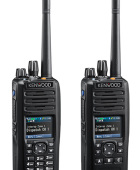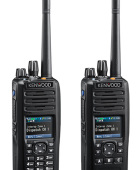Nexedge
*This page contains content that may not be visible on mobile devices.
Kenwood is pleased to introduce NEXEDGE™ conventional and trunking technology featuring 6.25 kHz digital narrowband operation. NEXEDGE™ was designed to provide advanced communication solutions that meet the needs of private enterprise and public sectors today and in the future.
In analog systems as the signal strength decreases in low-coverage areas, noise and dropouts increase, severely degrading intelligibility. However, with the NXDN® digital system, which features enhanced Forward Error Correction (FEC), the digitized audio stream is less susceptible to noise, resulting in superior clarity at varying signal strengths. System operators converting from analog to NEXEDGE® typically comment that users now receive calls in areas that were out of range before. NXDN® reduces lost or misinterpreted calls and the need for repeat calls, thus enhancing workforce productivity.
NXDN
A key element of the NXDN® air interface is the AMBE+2™ vocoder which digitizes speech while retaining natural voice nuances, performs noise reduction, introduces FEC and compresses this voice data to accommodate land mobile radio data rates. Next, the radio’s digital signal processor (DSP) protocol- packages the vocoder, signaling, control, and more FEC data together and converts this to a uniquely filtered 4-Level FSK digital waveform that modulates the transmitter. This results in an unusually low bit-error-rate digital air interface delivering robust communications even in weak signal strength areas. The NXDN® air interface is capable of fitting into both narrow 12.5 kHz and very narrow 6.25 kHz bandwidth channels meeting the tightest of spectrum efficiency requirements (9600 bps @ 8.3 kHz and 4800 bps @ 4 kHz occupied bandwidth respectively). NXDN® is a Frequency Division Multiple Access (FDMA) methodology whereby one user accesses a channel frequency at any one point in time (i.e. accesses via the frequency domain). Other digital methods such as Time Division Multiple Access (TDMA) permit more than one user to access the channel frequency via timeslots (i.e. accesses via the time domain), but there has to be a tradeoff between coverage and effective transmission rate, as increasing the former means decreasing the latter.
Kenwood Nexedge Product Line
NX-5800
Kenwood’s first dual-mode portable and mobile radios that will operate on either the NXDN or P25 network, the ground-breaking NX-5000 series.
NX-5700
Kenwood’s first dual-mode portable and mobile radios that will operate on either the NXDN or P25 network, the ground-breaking NX-5000 series.
NX-5400
Kenwood’s first dual-mode portable and mobile radios that will operate on either the NXDN or P25 network, the ground-breaking NX-5000 series.
NX-5300
Kenwood’s first dual-mode portable and mobile radios that will operate on either the NXDN or P25 network, the ground-breaking NX-5000 series.





